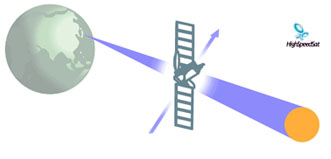Solar Satellite Signal Outages
This natural phonomenon happens twice a year when a satellite and a receiving earth station come directly in line with the sun. The energy from the sun interferes with the satellite's signal and causes this loss in transmission. - During two weeks each year, energy from the sun can overpower a satellite's signal. This is called a sun fade, sun transit or sun outage. These outages occur during the spring and fall, and only last for a few minutes during each occurrence. The times can be predicted, as they occur on a regular schedule.![]()
During certain times of the year for several minutes every day, energy from the sun can overpower a satellite's signal. This is called a sun fade, sun transit or sun outage. Use PanAmSat sun outage calculator to estimate the times that your signal may be potentially degraded.
Commercial communications satellites are geostationary and therefore have orbits that lie in the equatorial plane. During the spring and fall equinoxes, the sun also passes through this plane. As seen from the ground, the sun seems to pass behind the satellites once per day. During the time when both the satellite and the sun are in the ground station's field of view, the energy from the sun can overpower the signal from the satellite. It is this loss or degradation of communications traffic from the satellite that is referred to as sun fade, sun transit or sun outage. The duration of the sun outage depends on several things: the beam width of the field of view of the receiving ground antenna, the apparent radius of the sun as seen from the Earth (about 0.25°), the RF energy given off by the sun, the transmitter power of the satellite, the gain and S/N performance of the ground station receive equipment, and other factors. All this can be used to determine the outage angle of the receive antenna. Outage angle is defined as the separation angle (measured from the ground station antenna) between the satellite and sun at the time when sun outage or signal degradation begins or ends (see diagram).
The exact point at which sun outage begins and ends is difficult to determine as it is a gradual transition. Also, due to the many differences in ground station equipment, some stations may experience a complete loss of signal while others may only experience a tolerable degradation of signal. This makes the determination of antenna outage angles difficult without complete information about the ground station equipment. For this reason, the following approximations were used to generate the antenna outage angles attached later:
OutageAngle = 11 (Freq)(Diam) + 0.25° where: Freq = Downlink Frequency in GHz (11.95 for Ku) Diam = Dish diameter of ground station receive antenna in meters.
Geostationary Satellites
Geostationary or communications satellites are PARKED in space 22.300 miles (35.900. km) above the equator of the STATIONARY earth. Geostationary satellites are used for weather forecasting, satellite TV, satellite radio and most other types of global communications.
At exactly 22.300 miles above the equator, the force of gravity is cancelled by the centrifugal force of the rotating universe. This is the ideal spot to park a stationary satellite.
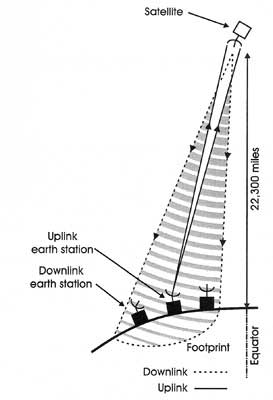
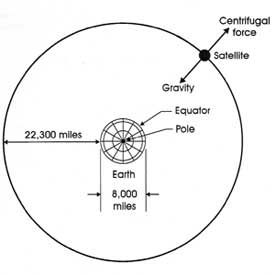
At exactly 22.000 miles (35.900. km) above the equator, the earth's force of gravity is canceled by the centrifugal force of the rotating universe. This is the ideal location to park a stationary satellite. The signal to the satellite is very, very precise and any movement of the satellite would cause a loss of the signal.
Sun outages affect a geostationary satellite
Geostationary satellites are fantastic means of communication except for one little problem called SUN OUTAGES. These sun outages happen during March and September when the sun passes the equator. Here is a quote from the book Satellite Technology:
"The elevated temperature of the sun causes it to transmit a high-level electrical noise signal to receiving systems whenever it passes behind the satellite and comes within the beams of the receiver antennas. The increase in noise is so severe that a signal outage usually results. The length and number of the outages depends on the latitude of the earth station and the diameter of the antenna. At an average latitude of 40° in the continental United States, and a 10-meter antenna, the outages occur over 6 days with a maximum duration of 8 minutes each day. With a less directional 3-meter antenna, the outages occur over 15 days, with a maximum duration of 24 minutes."(Satellite Technology, p. 13).
2 times each year the sun passes the equator as it makes it north-south spiral. On that time, the sun lies on the celestial equator. The word equinox refers to the fact that, on this day, the night is equal to the day: each is twelve hours long. The sun is directly above the equator, so its rays fall vertically down.
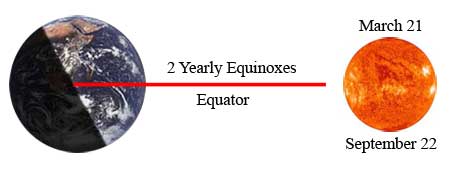 The sun moves across the equator twice a year giving us the vernal (spring) and fall (autumnal) equinoxes.
The sun moves across the equator twice a year giving us the vernal (spring) and fall (autumnal) equinoxes.
Unfortunately the stationary satellites eclipses the sun and that causes electrical noise or interference to the broadcasting signals.
Obviously the Jesuits forget to change the definition of the word EQUINOX in the English dictionary because it still gives the true scientific definition of the word with the sun MOVING across the equator 2 times each year:
"Either of the two times during a year when the sun crosses the celestial equator and when the length of day and night are approximately equal; the vernal equinox or the autumnal equinox."(Webster's Third New International Dictionary).
Description of sun outages
PanAmSat's commercial communications satellites are geostationary, and therefore have orbits that lie near the equatorial plane. During the spring and fall equinoxes, the sun also passes close to this plane. As seen from the ground, the sun seems to pass behind the satellites once per day. During the time when both the satellite and the sun are in the ground station's field of view, the RF noise energy from the sun can overpower the signal from the satellite. It is this loss or degradation of communications traffic from the satellite that is referred to as sun fade, sun transit or sun outage (see diagram).
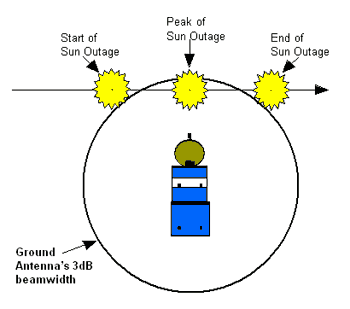
The duration of the sun outage depends on several things such as: the beam width or field of view of the receiving ground antenna, the apparent radius of the sun as seen from the Earth (about 0.25°), the RF energy given off by the sun, the transmitter power of the satellite, the gain and S/N performance of the ground station receive equipment, along with other factors. All this can affect whether a ground station will experience a complete loss of signal or only a tolerable degradation in signal quality. The exact point at which sun outage begins and ends is difficult to determine since it is a gradual transition. The gain of an antenna falls off sharply outside the 3dB beam width, but it does not immediately go to zero. Therefore, if the sun is just outside the antenna's beam width, it can still contribute noise and degrade system performance. This makes it difficult to define exactly what conditions constitute a sun outage.
How the program works
To aid with sun outage predictions, a parameter called outage angle is defined for the ground station. Outage angle is defined as the maximum separation angle (measured from the ground station antenna) between the satellite and the sun's center, that results in a sun outage. In other words, if the separation between the satellite and sun is less than the specified outage angle, then the station is said to be experiencing a sun outage. Otherwise, the station is not experiencing a sun outage (see diagram).
 TCP/IP Acceleration:
The use of the TCP/IP protocol over satellite is not good and a number of companies have developed ways of temporarily changing the protocol to XTP over the satellite link to achieve IP acceleration. See http://www.packeteer.com/resources/?attrvalue=75 for an example
TCP/IP Acceleration:
The use of the TCP/IP protocol over satellite is not good and a number of companies have developed ways of temporarily changing the protocol to XTP over the satellite link to achieve IP acceleration. See http://www.packeteer.com/resources/?attrvalue=75 for an example
Satellite Internet Explained In Plain English: Latency
Latency is the amount of delay, measured in milliseconds, found in a round-trip data transmission. Not directly related to speed, latency can be an issue with all networks including satellites. Latency is caused by several factors, including the number of times the data is handled along the transmission path, for instance, by a router or server. Each time a data packet is handled by a device along the path (called a “hop”) several milliseconds of latency are induced. More importantly in the satellite world, latency is caused by the distance that the signal must travel. The satellites used for two-way Internet service are located approximately 23,000 miles above the equator. This means a round-trip transmission travels 23,000 miles to the satellite, 23,000 miles from the satellite to the remote site, and then as the TCP/IP acknowledgment is returned, another 46,000 miles on the return trip. That's a total round trip of about 92,000 miles. Even at the speed of light, this accounts for more delay (in milliseconds) than found in a terrestrial network. Most Internet applications including web browsing, email, FTP etc. work in their normal manner even when traversing this long distance and user experiences are very positive. Certain applications, such as Voice-Over-IP are affected but also work. Some applications, such as online gaming are not recommended. Citrix, and terminal emulators without local-echo, can also be affected by latency depending on the underlying application and configuration. If you have an application that is particularly sensitive to latency, it is highly recommended that customers check with their software vendor to confirm how specific applications are affected.
VSAT Systems connects the secure traffic between your private satellite network and your companies headquarters network across a variety of customer-selected options including point-to-point T-1, Frame Relay PVC or VPN across the Internet. Since the Internet method is by far the least costly, it is the most popular.
This technology approach completely avoids the performance problems of VPN-over-satellite because there is no traditional VPN being used across the satellite portion of the connection.
TCP/IP over Satellite

IRIDIUM 9500 phones in the box
It takes time for a satellite signal to be sent from your dish to the orbiting satellite back down to Earth… The speed of light is 186,000 miles per second and the orbiting satellite is 22,300 miles above earth. Calculated out, satellite latency is roughly ˝ of a second, which is not a lot of time, but a few applications such as VPN (Virtual Private Network) don’t like this time delay. It is important to know if Satellite Latency will affect the way you will use the Internet.
A MISCONCEPTION ABOUT SATELLITE LATENCY
A common misconception is that latency has an effect on transfer rate. This is not true. A one Megabyte file will transfer just as quick over a 1000Kbps satellite connection as it does over a 1000Kbps terrestrial connection. It just takes the satellite connection less than a second for the file to begin transferring.
Motorola Satellite Phones
The speed of light also has some profound implications for networking technology as well. Light, or electromagnetic radiation, travels at 299,792,458 meters per second in a vacuum. Within a copper conductor the propagation speed is some three quarters of this speed, and in a fibre optic cable the speed of propagation is slightly slower, at two thirds of this speed. Why is this relevant to network performance? While it may take only some nanoseconds to pass a packet across a couple of hundred meters within a local area network, it takes considerably longer to pass the same packet across a continent, or across the world. In many parts of the world Internet services are based on satellite access. Often these satellite-based services compete in the market with services based on terrestrial or undersea cable. And even with undersea cables, the precise path length used can also vary considerably. What's the difference? The essential difference is "latency", or the time taken for a packet to traverse the network path. Latency is a major factor in IP performance, and reducing or mitigating the effects of latency is one of the major aspects of network performance engineering. And the time taken to get a packet through a network path is dependant on the length of the path and the speed of propagation of electromagnetic radiation through that medium. And this delay becomes a very important factor in network performance.
Why is Network Latency so Important for TCP/IP In order to understand why this is the case it is appropriate to start with the IP protocol itself. IP is a 'datagram' protocol. For data to be transferred across an IP network the data is first segmented into packets. Prepended to each packet is an IP protocol header. IP itself makes remarkably few assumptions about the characteristics of the underlying transmission system. IP packets can be discarded, reordered or fragmented into a number of smaller IP packets and remain within the scope of the protocol. The IP protocol does not assume any particular network service quality, bandwidth, reliability, delay, variation in delay or even reordering of packets as they pass through the network. In itself this unreliable services sounds like its not overly useful. If sending a packet through an IP network is an exercise in probability theory rather than a reliable transaction, then how does the Internet work at all? If we want reliable service then we need to look at a protocol that sits directly on top of IP in a stack-based model of the network's architecture. The real work in turning IP into a reliable networking platform is undertaken through the Transmission Control Protocol, or TCP. TCP works by adding an additional header to the IP packet, wedged between the outer IP packet header and the inner data payload. This header includes sequencing identifiers, fragmentation control fields and a number of control flags. TCP is a reliable data transfer protocol. The requirements for reliability in the data transfer implies that TCP will detect any form of data corruption, loss, or reordering on the part of the network and will ensure that the sender retransmits as many times as necessary until the data is transferred successfully. The essential characteristic of TCP is that the sender keeps a copy of every sent packet, and will not discard it until it receives an acknowledgement (ACK) from the other end of the connection that the packet has been received successfully. Of course sending data packet by packet and waiting for an acknowledgement each time would be a very cumbersome affair. TCP uses 'sliding window control' to send data. By this, it is meant that the sender sends a sequence of packets (a 'window'), and then holds a copy of these packets while awaiting ACKs from the receiver to signal back that the packets have arrived successfully. Each time an ACK for new data is received, the window is advanced by one packet, allowing the sender to send the next packet into the network. The packets are numbered in sequence so that the received can resort the data into the correct order as required. TCP also uses a form of adaptive rate control, where the protocol attempts to sense the upper limit of sustainable network traffic, and drive the session at a rate that is comparable to this maximal sustainable rate. It does this though dynamically changing the size of the sliding window, coupled with monitoring of packet loss. When TCP encounters packet loss, as signalled by the ACK return packets, it assumes that the loss is due to network congestion, and the protocol immediately reduces its data transfer rate and once more attempts to probe into higher transfer rates. This control is undertaken in TCP by adjusting the size of the sliding window. The way in which TCP adjusts its rate is by increasing the window each time an ACK for new data is received, and reducing the window size when the sender believes that a packet has been discarded. There are two modes of window control. When starting a TCP session a control method called "slow start" is used, where the window is increased by one packet each time an ACK is received. If you get an ACK for every sent packet, then the result is that the sender doubles its window size, and hence doubles its data transfer rate, for each time interval required to send a packet and receive the matching ACK. Networking is not a science of the infinite, and a sender cannot continuously increase its sending rate without limit. At some stage the receiver will signal that its receiving buffer is saturated, or the sender will exhaust its sending buffer, or a network queue resource will become saturated. In the last case this network queue saturation will result in packet loss. When TCP experiences packet loss the TCP sender will immediately halve its sending rate and then enter "congestion avoidance" mode. In congestion avoidance mode the TCP sender will increase its sending rate by one packet every round trip time interval. Paradoxically, this rate increase is typically very much slower than the "slow start" rate. For TCP, the critical network characteristic is the latency. The longer the latency, the more insensitive TCP becomes in its efforts to adapt to the network state. As the latency increases, TCP's rate increase becomes slower, and the traffic pattern becomes more bursty in nature. These two factors combine to reduce the efficiency of the protocol and hence the efficiency of the network to carry data. This leads to the observation that, from a performance perspective and from a network efficiency perspective, it is always a desirable objective to reduce network latency. Of course these always a gap between theory and practice. The practical consideration is that TCP will only run as fast as the minimum of the size of the sending and receiving buffers in the end systems. On longer delay paths in the Internet its not the available bandwidth in the network thats the bottleneck, its the performance of the end system coupled with the network latency that limits performance.
HTTP protocol
http://www.ses-newskies.com/sunoutagedata.htmSOLAR OUTAGE known as SUN TRANSIT or SOLAR INTERFERENCE
The ultimate noise, solar outage. This is one of the items no one ever pays any attention to except satellite service providers and owners of commercial installations and then when it happens to you, as a homeowner, and your TV image goes from excellent to sparkly to all snow you get a quick lesson in what it is all about. It is a phenomenon unique to the satellite world.
Twice a year, in the spring and the fall, coincident with the spring and fall equinoxes (March 20/21 and September 20/21, i.e. when the seasons change), the sun passes across the equator where it crosses (passes) directly behind each satellite in the orbital belt. Remembering that the directional beam of a ground station, i.e. satellite dish, is always set to face a geostationary satellite, on the day when the sun is directly behind an orbiting satellite it will cast a perfect shadow of the dish feed assembly into the very center of the dish, i.e.when the main beam of an earth station receiving antenna is in direct line of sight with the sun it is when sun outage occurs. As the sun passes the antenna beam's field of view, the ground station's receiver picks up the sun interference (as transmitted through the feed assembly) and that causes a drastic deterioration of the receive C/N (carrier to noise ratio); in other words, it is all noise and no carrier. We also use S/N (signal to noise ratio) equivalently with C/N. Basically, the satellite signal is overwhelmed by the unwanted signal from the sun; the signal from the sun is what we call noise. This phenomenon behaves as if the noise temperature rises in the ground station's receiver.
At this time, until the sun moves, it will cause about ten minutes loss of signal from that satellite. On the days before and after when the sun is directly aligned with that satellite there will be less outage - as it approaches alignment with a satellite, each day there is more outage than the preceeding; and as it moves away from alignment with a satellite, each day there is less outage. Of course, the actual days and times when your dish will be affected depends on your latitude and longitude, longitudinal position of the satellite, and diameter of the dish. For the March equinox, solar outage begins in February, affecting the northernmost latitudes, moving to affect the equator on the day of the equinox, and ends in April, affecting the southernmost latitudes. For the September equinox, the travel pattern of the sun is reversed so the pattern of solar outage begins in the southernmost latitudes, in August, and ends at the northernmost latitudes in October. Note that sun outage effects are vice versa between the southern and northern hemispheres. For cases where a ground station is located west of the affected satellite, sun interference occurs in the morning; and for a ground station east of the affected satellite, sun interference is in the afternoon.
If you have a bright, shiny (or light colored), solid satellite dish, then the sun is 'cooking' your dish electronics so during periods of solar outage it is best to move the dish to another location. Mesh antennas rarely have a problem with overheated feed electronics during periods of solar outages. The actual mechanics of solar outage are that the solar flux, which is radiated in the 4 and 12 GHz frequency bands, introduces additional noise into the antenna, forcing system noise temperature to rise. This occurs because the satellite's weak coherent microwave streams become overwhelmed in the microwave noise from the sun. In turn, this noise causes receivers to operate near or below their threshold. Solar outage affects only the downlink, not uplinks.
How adverse will be sun outages can be determined with diameter of an antenna, signal margin of the ground station, noise temperature of the receiver and noise inherent to the total communication system. But beyond the esoteric calculations, we know that diameter of a receive dish is related to quality of received signal; specifically, dish gain increases proportionally to diameter of the dish so the intensity of the effects of sun outages increases (is greater) in larger dishes.
However, the larger diameter a receive antenna is, the shorter time and the fewer days sun interferences last. We prove this by the following formula: 'B = 0.5 + Bo' where 'B' is the angle of degrees at which the sun crosses the half power beamwidth of a receive antenna and where the half power beamwidth of the antenna is 'Bo'. (Note the apparent diameter of the sun as seen from the Earth is about '0.5' degree.) The sun rotates one degree in 4 minutes therefore the longest time length the sun moves by the receive antenna's half power beamwidth is calculated as follows: 'B degrees x 4 minutes/degree'; and noting the sun's declination changes 0.4 degree a day, the maximum number of days the sun stays within the receive antenna's half power beamwidth is: 'B degrees / 0.4 degrees/days'. A value of the receive antenna's half power beamwidth, 'Bo', for typical parabolic antennas, where wave length of receive frequency is 'L' and diameter of antenna is 'D', is predicted as follows: 'Bo = 70 x L / D' so that 'Bo' increases with smaller dish diameters. (If you have ever tuned a large diameter dish then you know that it is more difficult to tune than a smaller diameter dish and that is because it is more focused in its center beam, i.e. its half power beamwidth is smaller.) Therefore, the larger diameter a receive antenna is, the shorter time and the fewer days sun interferences last.
References and White Papers
SOLAR OUTAGE REFERENCES related links:
solar outage (sun transit) discussion of what it is, and here are links to sites with outage info: Panamsat - includes all PAS, Galaxy and SBS satellites; Intelsat and non Intelsat under Intelsat management; New Skies; GE Americom - a program to be downloaded or on-line (must complete registration form first); Asiasat; JCSat; North America Satellites Only - all time zones and by latitude, Echostar 3 to Echostar 4; North America Satellites Only - SBS 6 to Satcom C1; Brazilsat - B series; sats; Telesat - for Canadian sats; - online submission form; for Thaicom 1/2/3, Measat 1, PAS 2/4, Intelsat 702/804.NOTE: Astra, Loral, Eutelsat do not have sun outage pages listed at their web sites. Satellite Phone Blog - Comment the latest news and info from satellite phone arena
